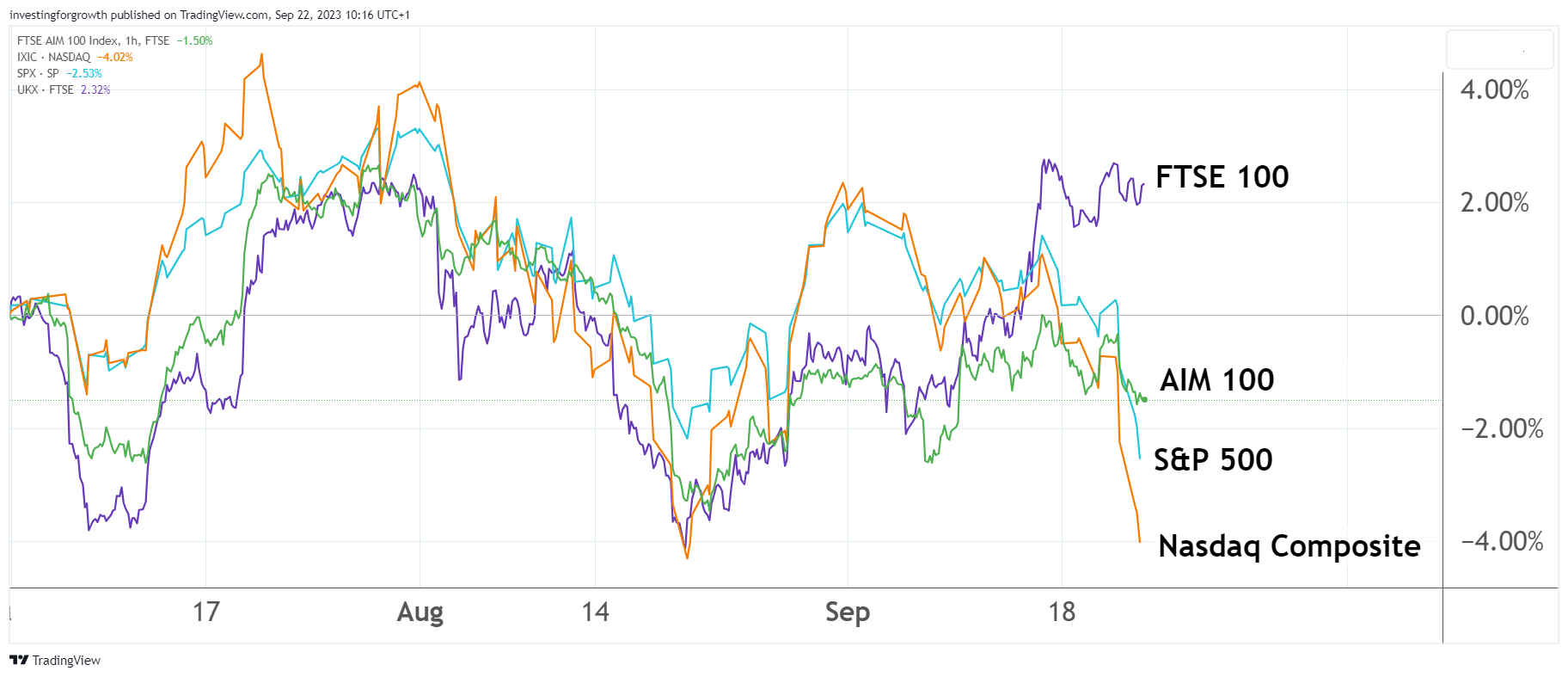The long-term outlook for AIM is positive
Smaller companies have been hit hard this year, but AIM has outperformed many of the big stock markets in the third quarter. Award-winning AIM writer Andrew Hore discusses takeover activity, interest rates and when the small-cap recovery might begin.
22nd September 2023 15:03
by Andrew Hore from interactive investor

AIM remains rock bottom when it comes to performances of the main global stock markets. All three measures of AIM – AIM 50, AIM 100 and AIM All-Share - have fallen by more than 11% so far this year. UK markets in general have not performed as well as markets in many other countries, but the larger companies have at least risen in value this year.
- Invest with ii: Top UK Shares | How to Start Trading Stocks | Open a Trading Account
In contrast, the Nasdaq Composite index is more than one-quarter higher, and the Nasdaq 100 is doing even better, with a one-third increase. The FTSE World index is nearly 10% ahead, compared with a 3% rise in the FTSE 100. The Japanese, German and French markets are all doing better than the UK. Hong Kong and China are the only markets that get near to the losses experienced by AIM this year, along with the FTSE Fledgling index.
This shows that smaller companies are sharply underperforming the larger companies, and it is not just those on AIM. They are undoubtedly out of favour, although this will not go on forever.
In the period since the end of June, AIM has not done so badly. Even though it has fallen – the AIM 100 is down 1.6% and AIM All-Share down 1.9% - many others have done much worse. In fact, of the overseas exchanges, only India’s Mumbai index, Brazil’s Bovespa and the Dow Jones have done better than the AIM All-Share so far in the third quarter.
AIM performance in third quarter 2023 so far

Source: TradingView. Data from 30 June to 21 September 2023. Past performance is not a guide to future performance.
The FTSE AIM All-Share index and the FTSE AIM 100 are both outperforming Nasdaq (down over 4%) with a decline of less than 2%. The outlier is the FTSE AIM UK 50 index, which is 3.4% lower, although it is still outperforming the Nasdaq.
That’s because the AIM 50 is most dependent on UK companies, whereas the AIM 100 and the Main Market index FTSE All-Share and its related measures are more heavily influenced by international companies. This a criticism aimed at the FTSE 100 index, in particular, which is thought to be a poor measure of the UK economy.
AIM stocks and high interest rates
Sectors that typically benefit from higher interest rates are defensives such as utilities, and they are generally much larger companies. That is a potential reason why the performance of smaller companies can underperform larger counterparts. Utilities and telecoms make up less than 4% of the market capitalisation of AIM.
The economic outlook for the rest of the year remains uncertain. If inflation continues to fall, then that should help investor confidence return. Energy and other costs are easing, which provides an improving backdrop for many AIM companies. There are still concerns about wage rises, though.
At the beginning of September, analysts at Shore Capital said there were more positive trading statement surprises than negative ones among the companies it follows during August. September, of course, is an important time for results and trading statements and, while there has been good news, there have also been some shocks that have hurt share prices of individual AIM companies.
- AIM ISAs are 10 years old: these shares are the big winners
- Stockwatch: should you jump on the rebound in this AIM growth stock?
It is noticeable that there are plenty of consumer-related businesses reporting on trading in the past month that have disappointed the market, and share prices have slumped.
For example, trading has deteriorated since August at replacement windows supplier Safestyle UK (LSE:SFE)and the forecast 2023 loss has jumped to £10 million. The market is estimated to have fallen by 24% in July and August, while Safestyle orders were 11% lower in August. Net debt could reach £6.5 million at the end of 2023 – the current bank facility is £7.5 million. That is not a good position to be in considering the uncertain outlook. Management wants to strengthen the balance sheet, so there could be a share issue.
Fashion retailer QUIZ (LSE:QUIZ) is another company where revenues are falling. In the five months to August 2023, there was a 15% decline to £37 million and a sharp drop in traffic to the company’s websites. Full-year revenues could be 7% below previous forecasts and Quiz will move back into loss.
Online publisher Digitalbox (LSE:DBOX) says interim revenues were £1.2 million, which was ahead of expectations, but in the second half traffic numbers coming to its websites have been poor. That is partly due to less traffic coming via Alphabet Inc Class A (NASDAQ:GOOGL) and Meta Platforms Inc Class A (NASDAQ:META), which are trying to retain traffic for their own sites. Other changes by sources of traffic are also affecting the figures.
Although traffic is down, the session values are higher. While the changes in the sourcing of traffic have been a major factor, but there is probably some influence from the weak consumer market.
Cosmetics supplier Warpaint London (LSE:W7L) is bucking the trend, but that’s because it is in the value end of the cosmetics market. It is also adding retailers and benefiting from the international spread of the business. UK interim revenues were 28% ahead, while group revenues were 46% higher.

Bad time to be short of cash
This is still not a time to have to raise cash. There have been some substantial share price discounts for fundraisings that are required to keep the business going, particularly when there is little in the way of revenues and no earnings.
An example is battery technology developer Amte Power Ordinary Shares (LSE:AMTE). It secured a £1 million loan facility from Arena Investors, which has also relinquished conversion rights on the £3.75 million convertible bond in return for warrants over 2% of the enlarged share capital. This loan was designed to provide time to complete a £2.5 million subscription at an indicative price of 1.7p/share, subject to due diligence. Back in June, the day before the need for the cash was revealed, the share price was 51p.
- Stockwatch: a small-cap share defying the gloom
- Stockwatch: I rate these three stocks at inflection point a ‘buy’
However, with due diligence dragging on, AMTE Power raised £2.1 million at 1.7p/share, while a retail offer could raise up to £250,000. The battery technology developer is raising the cash to keep going until due diligence is completed, which may continue until the end of October. Trading in the shares has been suspended at 2.24p because of non-settlement of some trades. This can happen with highly volatile and declining share prices.
North Sea oil and gas producer IOG (LSE:IOG) is another company that requires a refinancing. Discussions concerning the company’s €100 million senior secured bond continue and the interest payment waiver lasts until 29 September. This comes at a time when gas prices have fallen, thereby hitting cash flow. The share price has fallen by 94% this year.
Bidders approach undervalued AIM companies
Bids may continue to help the performance of AIM. These provide an indication of the undervalued nature of some AIM companies. The bids tend to be for the stronger, better performing companies. The premia to the market price can be substantial.
Some of the recent bids include pharma IT provider Instem (41% premium), cyber security firm Blancco Technology (25% premium), Osirium Technologies (96% premium) broker Numis (72% premium) and pharma services provider Ergomed (28% premium).
Many of these are private equity backed bids where they have spotted the excellent value because of depressed share prices.
Timeline for a small-cap recovery
It seems that UK interest rates have peaked or are not going to go much higher. That is normally the time when smaller companies start to recover.
The recovery in AIM shares in March 2020 was unusual in that it happened earlier than for larger companies. It appears that this time there is going to be the normal lag before AIM improves. The recent strength of the larger companies in London may still take some time to show through in a bounce back for AIM, but if those larger Main Market companies continue to rise, then it is sure to happen.
It does appear that there could be an additional lag for the AIM companies more focused on the UK market, though. The bids and bid approaches show that there is value, particularly in the more solid businesses where share prices have fallen back over the past couple of years, but the businesses have continued to progress, and their ratings are relatively low.
There could be significant upside for some of the more speculative companies as well, but there are likely to be plenty of shocks from these companies. Those with high borrowings at the current rates of interest will be vulnerable to demands from the banks, and even if they can raise money via a share issue, it will be at a sharp discount to the market price and dilute existing shareholders.
The long-term outlook for AIM is positive, but investors should remain cautious about the shares they invest in.
Andrew Hore is a freelance contributor and not a direct employee of interactive investor.
These articles are provided for information purposes only. Occasionally, an opinion about whether to buy or sell a specific investment may be provided by third parties. The content is not intended to be a personal recommendation to buy or sell any financial instrument or product, or to adopt any investment strategy as it is not provided based on an assessment of your investing knowledge and experience, your financial situation or your investment objectives. The value of your investments, and the income derived from them, may go down as well as up. You may not get back all the money that you invest. The investments referred to in this article may not be suitable for all investors, and if in doubt, an investor should seek advice from a qualified investment adviser.
Full performance can be found on the company or index summary page on the interactive investor website. Simply click on the company's or index name highlighted in the article.
Disclosure
We use a combination of fundamental and technical analysis in forming our view as to the valuation and prospects of an investment. Where relevant we have set out those particular matters we think are important in the above article, but further detail can be found here.
Please note that our article on this investment should not be considered to be a regular publication.
Details of all recommendations issued by ii during the previous 12-month period can be found here.
ii adheres to a strict code of conduct. Contributors may hold shares or have other interests in companies included in these portfolios, which could create a conflict of interests. Contributors intending to write about any financial instruments in which they have an interest are required to disclose such interest to ii and in the article itself. ii will at all times consider whether such interest impairs the objectivity of the recommendation.
In addition, individuals involved in the production of investment articles are subject to a personal account dealing restriction, which prevents them from placing a transaction in the specified instrument(s) for a period before and for five working days after such publication. This is to avoid personal interests conflicting with the interests of the recipients of those investment articles.